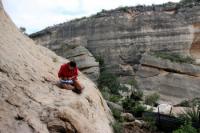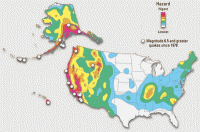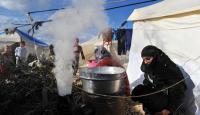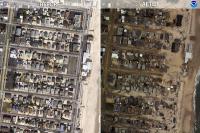-
Bikini islanders petition to relocate to U.S. as rising seas threaten to swallow their island

About 1,000 Bikini islanders have petitioned to be relocated to the United States as rising seas threaten to swallow their adopted home. Several hundred islanders were moved from their homes on the Bikini Atoll in 1946 when the United States decided to use it for nuclear weapons tests. In 1948 the islanders were settled on a nearby island in the Marshall chain called Kili. In the last decade, however, climate change and sea level rise have made life on Kili dangerous, as the island has been steadily losing the struggling against huge tides and increasingly ferocious storms.
-
-
Climate change heightening the risk of conflict and war
Thirty of Australia’s leading minds from defense, academia, policy think tanks, and other government agencies have joined together for discussions over two days last week for Australia’s first climate security summit. The summit participants agreed that increasing temperatures, rising sea levels, changing rainfall patterns, and more frequent and severe extreme weather events are heightening the risk of conflict and increasing the displacement of people. The summit organizers quote Brigadier-General Wendell Christopher King (Ret.), the Chief Academic Officer at the U.S. Army’s Command and General Staff College, who said: “[Climate change] is like getting embroiled in a war that lasts 100 years — there is no exit-strategy.”
-
-
FEMA paid $250 million in duplicate benefits after Hurricane Sandy: DHS IG
The Department of Homeland Security’s Office of Inspector General (OIG) says it used “innovative data matching tools” to determine that the Federal Emergency Management Agency (FEMA) paid approximately $250 million in disaster assistance to more than 29,000 Hurricane Sandy applicants who may have received duplicate benefits from their private insurers.
-
-
Extreme weather events in Chesapeake Bay offer clues for future

For the millions of people who live in its expansive coastal areas, Chesapeake Bay provides an important source of income and recreational enjoyment. To protect the ecosystem and the livelihood of area residents, it is important to assess how climate variability and change will affect Chesapeake Bay’s shallow water ecosystems and water quality.
-
-
Analyzing bedrock could help builders, planners identify safe building zones

Research could give builders and urban planners more detailed information about how susceptible areas are to landslides and earthquakes. The researchers focused on bedrock, just beneath the soil and roots and the Earth’s surface. Bedrock is the layer at the bottom of what geologists refer to as the “critical zone” because its cracks and fractures provide pathways for air and water, which break down rock and form the soil that is an essential ingredient for all living organisms.
-
-
Measuring performance of earthquake hazard maps

Earthquake hazard maps use assumptions about where, when, and how big future earthquakes will be to predict the level of shaking. The results are used in designing earthquake-resistant buildings. “Sometimes the maps do well, and sometimes they do poorly. In particular, the shaking and thus damage in some recent large earthquakes was much larger than expected,” says one researcher. Part of the problem is that seismologists have not developed ways to describe how well these maps perform.
-
-
Safe! Halloween asteroid to miss Earth

Halloween, according to some, is a time to be afraid, but no one need fear asteroid 2015 TB145, an object some 400 m across that will pass safely by at around 17:00 GMT (18:00 CET) on 31 October. The asteroid will safely miss Earth by just 480 000 km, which is further away from Earth than the Moon, but which is a close pass on a cosmic scale. The flyby highlights the need to watch for space rocks: Estimates give around 5,000 near Earth objects (NEOs) of this size, of which a significant fraction has not yet been discovered.
-
-
Syria’s civil war, Europe’s refugee crisis the result of spikes in food prices: Experts

The disintegration of Syria and Europe’s refugee crisis are only the latest tragic consequences of two spikes in food prices in 2007-08 and 2010-11 that triggered waves of global unrest, including the Arab Spring. Researchers have traced these spikes and spiraling crises to their root causes: deregulated commodity markets, financial speculation, and a misguided U.S. corn-to-ethanol fuel policy which removes nearly five billion bushels of corn from markets each year.
-
-
PNNL to help DHS address critical infrastructure vulnerabilities
The Department of Energy’s Pacific Northwest National Laboratory (PNNL) has been named a supporting laboratory to the National Infrastructure Simulation and Analysis Center (NISAC). NISAC is a Department of Homeland Security (DHS) program which addresses the potential vulnerabilities and consequences of disruption of U.S. critical infrastructure. PNNL says it will contribute advanced computer modeling and simulation capabilities to look at the dependencies, interdependencies, vulnerabilities, and complexities of important critical infrastructure sectors such as dams, water, transportation, energy, and information technology.
-
-
FEMA funding for post-Sandy recovery in New Jersey exceeds $6.8 billion

In the three years since Hurricane Sandy scored a direct hit on New Jersey, FEMA has provided $6.8 billion to date to help the state recover and rebuild. FEMA Public Assistance, which provides funds for repair and rebuilding of infrastructure and public facilities as well as necessary work such as debris removal and emergency response, has obligated $1.809 billion in Public Assistance funds towards repair and rebuilding projects in New Jersey.
-
-
Study: Persian Gulf could experience deadly heat
Detailed climate simulation shows that the Persian Gulf region would likely cross the threshold of survivability unless mitigation measures are taken. That tipping point involves a measurement called the “wet-bulb temperature” which combines temperature and humidity, reflecting conditions the human body could maintain without artificial cooling. That threshold for survival for more than six unprotected hours is 35 degrees Celsius, or about 95 degrees Fahrenheit, according to recently published research (the equivalent number in the National Weather Service’s more commonly used “heat index” would be about 165 F). The researchers say that hot summer conditions that now occur once every twenty days or so “will characterize the usual summer day in the future.”
-
-
Deadly extreme weather events to intensify, become more frequent over the next 50 years
European heat wave of 2003, during which 35,000 people died. It was the most extreme event of its kind since 1500 AD. In May 2015, India was struck by a severe heat wave that killed more than 2,500 people. “Heat waves that [were once] expected to occur twice a century [are now], in the early 2000s, expected to occur twice a decade. Human influence has very likely at least doubled the likelihood of such an event,” says one expert.
-
-
FEMA aid for New York’s Hurricane Sandy recovery reaches $16.9 billion
FEMA and the U.S. Small Business Administration have disbursed nearly $16.9 billion for New York’s recovery since Hurricane Sandy made landfall on the East Coast three years ago. FEMA said that this amount includes more than $1 billion paid directly to survivors for housing and other essential needs through the Individuals and Households Program which ended 30 April 2014.
-
-
Concrete innovation makes Seattle skyscraper stable
All coupling beams in the 1.5 million-square-foot Lincoln Square Expansion — which includes luxury condos, a hotel, dining, retail and office space in two 450-foot towers in the heart of Seattle suburb Bellevue, Washington — are made of fiber-reinforced concrete using a unique design. These concrete coupling beams span doorways and windows, helping walls with such openings in them to function as a single structural unit, while bolstering the building as a whole against earthquakes. Traditionally, coupling beams are reinforced with a labyrinth of rebar, adding a great deal of time, cost and complexity to the construction process.
-
-
Tsunami-prone nations should follow Japan’s new approach to coastal defenses
Japan’s lead in implementing sea defense improvements to guard against future disasters is an important reference point for other tsunami-prone nations. In the wake of the March 2011 Fukushima disaster, Japan has drawn new engineering guidelines which have transformed Japan’s coastal defenses, and has devised new ways to keep its coastlines safe in the future. Other nations in known tsunami risk areas, however, have not yet followed suit.
-
More headlines
The long view
Trump Aims to Shut Down State Climate Policies
By Alex Brown
President Donald Trump has launched an all-out legal attack on states’ authority to set climate change policy. Climate-focused state leaders say his administration has no legal basis to unravel their efforts.
